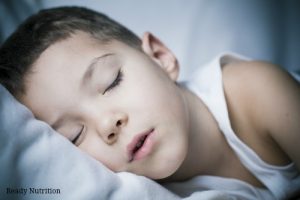 [1]
[1]So how much sleep do kids really need at each stage of development?
Babies up to a year – 12-16 hours (including naps).
Children 1-2 years – 11-14 hours (including naps).
Children 3 to 5 years – 10-13 hours (including naps).
Children 6 to 12 years – 9-12 hours.
Teens 13 to 18 years – 8-10 hours.
Now that school has started back up, now is the time to get your kids on the right sleep schedule; otherwise, they could develop some unhealthy habits. According to one article, some symptoms, like constant yawning or droopy eyes, are easy to recognize in a child. But others aren’t as obvious. Check out these common signs, which change as your little one gets older.
Young Children (Babies, Toddlers)
- Is cranky, whiny, or fussy, especially in the late afternoon on a regular basis
- Acts especially clingy, needy
- Displays fidgety, antsy, or hyperactive behavior
- Has trouble sharing, taking turns
- Is not talkative, taciturn
- Wakes up groggy; falls asleep after being woken up and needs to be woken again
- Wants to lie down or nap during the day
- Falls asleep during short car rides
- Has difficulty changing from two naps to one nap a day
- Snores
Kids In Elementary School
- Is hyperactive
- Falls asleep at inappropriate times
- Needs to be woken in the morning, sometimes multiple times
- Lacks interest, alertness, motivation, and/or an attention span
- Seems drowsy at school or at home during homework
- Has academic struggles
- Has trouble falling asleep
- Falls asleep during short car rides
- Experiences night terrors/sleepwalking for the first time
- Needs regular naps
- Exhibits loud snoring, breaks in breathing, or extreme restlessness at night
- Has anxiety about being separated from you during the day and night
Preteens/Teens
- Has extreme difficulty waking in the morning
- Is chronically late for school
- Experiences mood swings
- Has trouble concentrating
- Feels unmotivated
- Acts irritable in the early afternoon
- Falls asleep easily during the day
- Has academic troubles
- Sleeps for long periods on the weekends
- Is hyperactive or aggressive
- Acts nervous
- Consumes excessive amounts of caffeine
- Uses drugs
- Seems “Out of it” or confused
Source [3]
The Sleepy Three
If you see big gaps between how much sleep is recommended and what your children are actually getting, you might want to take stock of what I call the “sleepy three”—or how light, sound, and temperature are helping or hurting your child’s sleep habits.
Limit Light
It’s nothing new to say that a dim room is best for sleeping, but what you may not be aware of is how exposure to light even hours before bedtime can have a lasting negative effect on sleep. Blue light from television, iPads and computer screens is particularly damaging. It’s best to discontinue screen time about 4-5 hours before bedtime (i.e., if you want your kids asleep by 8pm, stop screens at 4); however, this might be difficult to enforce with older children and teens. For them, you can install blue light blocking apps such as f.lux [4] or Twilight [5] on their computers and devices.
In addition, blackout shades [6] ensure that seasonal changes in light will not have your kids up at the crack of dawn. Blackouts are also beneficial when you want to get little kids to sleep when it is still light outside (it’s amazing how bright it is at 7pm in June in the Northeast!).
Sound of Silence
Limiting ambient noise in any environment—whether it’s a busy city or a croaking bullfrog outside your window—is easy with a sound conditioner [7]. Simply plug in on your child’s bedside table and make it a habit to turn on as you turn off the lights. You’ll obscure any sounds outdoors and mask sounds coming from the house as well. This is particularly helpful for use with younger children who are still taking naps when the rest of the household is awake. (If, like me, you’ve read studies/worried about the effects of white noise on the ears of babies and small children, this article [8] may put your mind at ease).
Cooler is Better
Parents often worry about making sure their kids are warm enough at night but studies show [9] that a cooler sleeping space is optimal. The ideal room temperature should be between 60 and 67 degrees Fahrenheit. That’s quite chilly, but sleeping in cool rooms increases the production of melatonin, helps you fall asleep quicker, and can bring about increased incidences of REM cycle sleep.
Try using one or all three of the above tips to get your kids better quality sleep. Remember that sleep is critical for kids’ brain development, healthy metabolism, and mood regulation.
